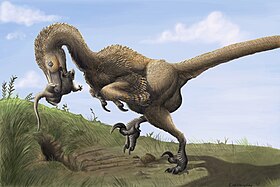Tar Heel/Coachman Formation
| Tar Heel/Coachman Formation Stratigraphic range: Campanian ~ | |
|---|---|
| Type | Formation |
| Unit of | Black Creek Group |
| Underlies | Bladen Formation |
| Location | |
| Region | |
| Country | |
The Tar Heel Formation is a geologic formation in North Carolina. It preserves fossils, including amber dating back to the Cretaceous period. A locality known as Phoebus Landing, has been dated to 78.5-77.1 Ma.[1]
Fish[]
Cartilaginous fish[2][]
Dinosaurs[]
Ornithopods[]
An indeterminate hadrosauroid is known from Stokes Quarry.[3]
| Ornithopods of the Tar Heel/Coachman Formation | ||||||
|---|---|---|---|---|---|---|
| Genus | Species | Location | Notes | Images | ||
| H. foulkii | Hadrosaurus can be found throughout Late Cretaceous Appalachia.[3] |
 Hadrosaurus foulkii | ||||
| "Hadrosaurus" | "H." minor | Phoebus Landing, North Carolina | A small or juvenile hadrosaur.[3] | |||
| H.crassicauda | Hypsibema was first discovered in North Carolina from Sampson County, 1869, and described by Edward Drinker Cope. It was measured to be 12-17 meters, making it one of the largest hadrosaurids. |  Hypsibema crassicauda | ||||
| L. sp. | Phoebus Landing, North Carolina | Lophorhothon was discovered in the Mooreville Chalk Formation, Alabama. | ||||
Ceratopsians[]
| Ceratopsids of the Tar Heel/Coachman Formation | ||||||
|---|---|---|---|---|---|---|
| Genus | Species | Location | Notes | Images | ||
| Indeterminate | Sampson County, North Carolina | In 2016, a left maxilla was found of a dinosaur from the Leptoceratopsidae, of an unknown genus. | ||||
Theropods[]
Indeterminate theropods, ornithomimosaurs, and maniraptorans are known from Stokes Quarry.[3]
cf. Coelosaurus[5]| Theropods of the Tar Heel/Coachman Formation | ||||||
|---|---|---|---|---|---|---|
| Genus | Species | Location | Notes | Images | ||
| Indeterminate | Phoebus Landing, North Carolina | An intermediate Ornithomimosaur | ||||
| Dromaeosaurine[6] | Indeterminate | Sampson County, North Carolina | A large dromaeosaurid, larger than Saurornitholestes but smaller than Dakotaraptor. | |||
| Dryptosauridae[3] | Indeterminate | Phoebus Landing, North Carolina | A large eutyrannosaur part of an early lineage related to Dryptosaurus. | 
| ||
| S. langstoni |
|
The first evidence of dromaeosaurids in Appalachia was uncovered through S. langstoni specimens found at Stokes Quarry and Burches Ferry. [3] |

| |||
References[]
- ^ Longrich, Nicholas R. (2016). "A ceratopsian dinosaur from the Late Cretaceous of eastern North America, and implications for dinosaur biogeography". Cretaceous Research. 57: 199–207. doi:10.1016/j.cretres.2015.08.004.
- ^ a b NCSM Paleontology Database
- ^ a b c d e f g h Brownstein, Chase D. (2018-02-08). "The biogeography and ecology of the Cretaceous non-avian dinosaurs of Appalachia". Palaeontologia Electronica. 21 (1): 1–56. doi:10.26879/801. ISSN 1094-8074.
- ^ Brownstein, Chase D. (2018-04-05). "Diversity of raptor dinosaurs in southeastern North America revealed by the first definite record from North Carolina". doi:10.7287/peerj.preprints.26829v1. Cite journal requires
|journal=(help) - ^ Baird D., and Horner, J., 1979, "Cretaceous dinosaurs of North Carolina" Brimleyana 2: 1–28
- ^ Brownstein, Chase D. (2018-12-01). "A large dromaeosaurid from North Carolina". Cretaceous Research. 92: 1–7. doi:10.1016/j.cretres.2018.07.006. ISSN 0195-6671. S2CID 135459468.
- ^ Brownstein, Chase D. (2018). "The distinctive theropod assemblage of the Ellisdale site of New Jersey and its implications for North American dinosaur ecology and evolution during the Cretaceous". Journal of Paleontology. 92 (6): 1115–1129. doi:10.1017/jpa.2018.42. ISSN 0022-3360.
Categories:
- Cretaceous geology of North Carolina



